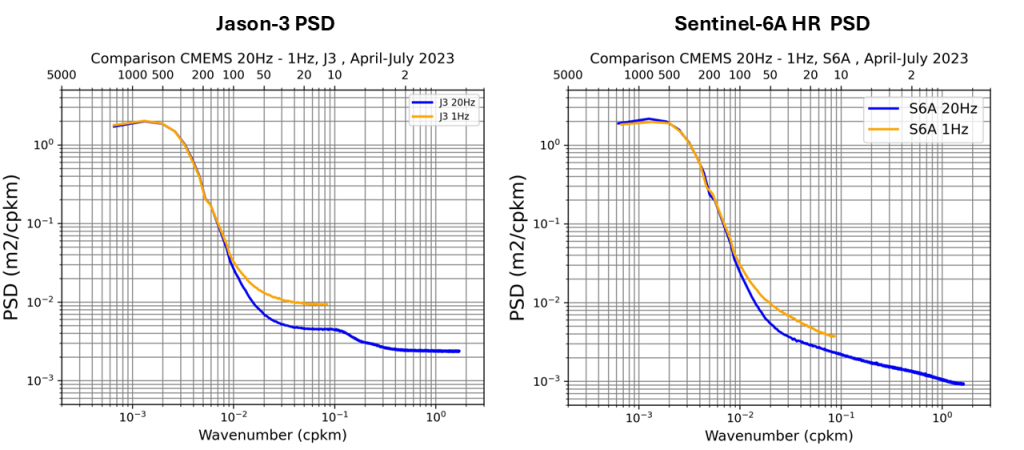Use new full-rate (20Hz) upstream for L3 1Hz production
DUACS-NG system version : 2.0.0
Implementation date : November 2023
After the start of the production of the Level-3 5Hz products in 2022 (see DUACS-NG v1.0.0), it is possible to design a L3 1Hz product using the full-rate (20Hz) upstream instead of the 1Hz version. This allows 1 Hz to benefit from the processing advances made on 20Hz/5Hz, namely:
- The noise level reduction possible with the High Frequency Adjustment (HFA) empirical correction available for some missions (see DUACS NRT altimeter standards).
- The new compression (20Hz to 1Hz) methodology applied on the corrected SLA variable rather than on the range measurement, allowing to exploit the high frequency content of the different fields involved in the processing.
This contributes to improve the quality of the resulting L3 1Hz product, with an improvement rate varying according to the altimeter mission considered. An example is provided in the folowing figure. It represents the PSD of the SLA deduced from the upstream 1Hz (orange line) and 20Hz (blue line). For two products/processing strictly equivalents, the two PSD should be perfectly aligned. The lower amplitude observed for the 20Hz measurements traduces the lower errors for this version. Part of the differences is also explained by the different segments available in 1Hz and 20Hz series.

The change in the L3 1Hz processing is associated with:
- a change of the production system. This may have a visible impact on the delay of processing and delay of availability of the final product for users
- a change in the products/datasets nomenclature: details are given in Table .
- a change of the NetCDF file nomenclature including “_1hz” for homogeneity with the nomenclature of the L3 5Hz products already available (e. g. nrt_global_s3b_phy_l3_1hz.nc)
See also the Product User Manual (PUM) for details.
Table : Changes in L3 NRT products/dataset nomenclature implemented in November 2023.
| Old product/dataset name | New product/dataset name |
| SEALEVEL_GLO_PHY_L3_NRT_OBSERVATIONS_008_044 | SEALEVEL_GLO_PHY_L3_NRT_008_044 |
| dataset-duacs-nrt-global-al-phy-l3 | cmems_obs-sl_glo_phy-ssh_nrt_al-l3-duacs_PT1S |
| dataset-duacs-nrt-global-c2n-phy-l3 | cmems_obs-sl_glo_phy-ssh_nrt_c2n-l3-duacs_PT1S |
| dataset-duacs-nrt-global-h2b-phy-l3 | cmems_obs-sl_glo_phy-ssh_nrt_h2b-l3-duacs_PT1S |
| dataset-duacs-nrt-global-s3a-phy-l3 | cmems_obs-sl_glo_phy-ssh_nrt_s3a-l3-duacs_PT1S |
| dataset-duacs-nrt-global-s3b-phy-l3 | cmems_obs-sl_glo_phy-ssh_nrt_s3b-l3-duacs_PT1S |
| SEALEVEL_EUR_PHY_L3_NRT_OBSERVATIONS_008_059 | SEALEVEL_EUR_PHY_L3_NRT_008_059 |
| dataset-duacs-nrt-europe-al-phy-l3 | cmems_obs-sl_eur_phy-ssh_nrt_al-l3-duacs_PT1S |
| dataset-duacs-nrt-europe-c2n-phy-l3 | cmems_obs-sl_glo_phy-ssh_nrt_c2n-l3-duacs_PT1S |
| dataset-duacs-nrt-europe-h2b-phy-l3 | cmems_obs-sl_glo_phy-ssh_nrt_h2b-l3-duacs_PT1S |
| dataset-duacs-nrt-europe-s3a-phy-l3 | cmems_obs-sl_glo_phy-ssh_nrt_s3a-l3-duacs_PT1S |
| dataset-duacs-nrteurope-s3b-phy-l3 | cmems_obs-sl_glo_phy-ssh_nrt_s3b-l3-duacs_PT1S |
Start of production over the global ocean
DUACS-NG system version : 2.0.0
Implementation date : November 2023
After the start of the production of the L3 5Hz datasets across Europe in November 2022 (see DUACS-NG v1.0.0), the production of the L3 5Hz datasets over the global ocean has started in November 2023. The processing applied is nearly the same as for Europe. The main difference is observed in the denoising processing step. The geographical variation of the observable wavelength (See Along-track Filtering) is indeed taken into account to adjust the cut-off frequency of the low-pass filtering applied (see Along-track Filtering). The global mean observable wavelength with these L3 5 Hz datasets is nearly ~40 km (S6A) to ~57 km (J3), depending on the altimeter considered (see Along-track Filtering). Over Europe, they range 43 km (S6A) to 59 km (J3) in the Atlantic part, and 33km (S6A) to 52 km (J3) in the Mediterranean Sea and Black Sea.
An estimation of the geostrophic current in the across-track direction is also provided. It is derived from the low-pass filtered SLA. The spectral analysis of the current obtained shows a good consistency with the SQG theory of the spectral slope at mesoscale in mid-latitudes areas. Nevertheless, below ~100km wavelength and in low-latitude areas, the spectral slope is far from SQG or QG theory and may represent the signature of residual noises on the filtered SLA (see Along-track Filtering).
Start L3 production for SWOT-nadir measurements
DUACS-NG system version : 2.0.0
Implementation date : November 2023
The satellite Surface Water Ocean Topography (SWOT) was launched in December 2022. After a CalVal phase, which lasted until mid-July 2023, the satellite was put on its scientific orbit, defined with a 21-day repeat cycle (see L2P upstream data). The satellite includes two types of altimeter measurement: a conventional nadir and a new swath measurement.
In November 2023, the SL-TAC started to use the SWOT nadir measurements in its production. The upstream 20Hz are considered and are used to compute L3 with 5Hz and 1Hz posting rate.
The CalVal analysis of the SWOT nadir measurement confirmed performances close to the Jason-3 mission.